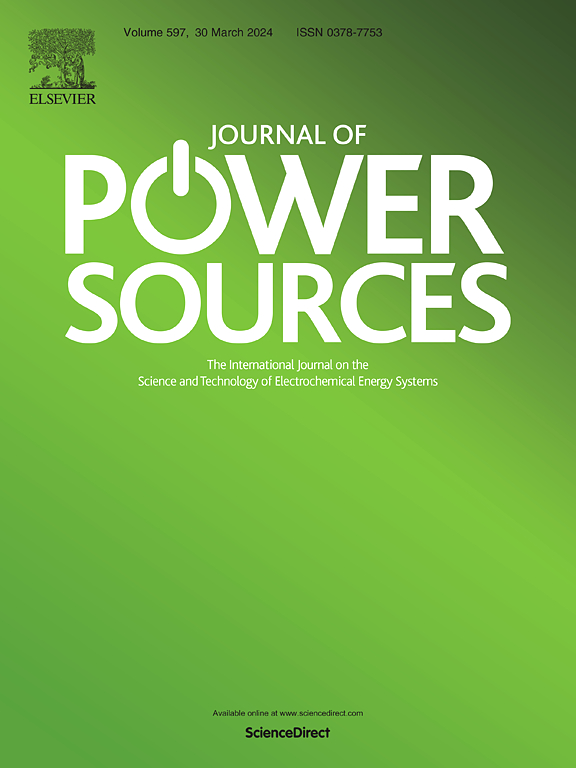Optimising lithium lanthanum cerate garnet ceramic electrolytes for fast lithium-ion conduction
IF 8.1
2区 工程技术
Q1 CHEMISTRY, PHYSICAL
引用次数: 0
Abstract
The garnet-type electrolytes are promising for solid-state lithium-metal batteries, while it is still challenging to realize fast lithium-ion conduction with moderate sintering process. To solve the problem, we proposed a novel cerium (Ce)-based cubic garnet electrolyte – Li6.25La3Ce1.25Ta0.75O12 (LLCTO-0.75). The Ta5+ doping of the tetragonal Li7La3Ce2O12 (LLCO) results in a stable cubic phase at room temperature, whilst the presence of Ce4+ is associated with enlarging lattice parameters to facilitate lithium-ion migration and promoting sintering. As a result, the LLCTO-0.75 achieves a dense ceramic microstructure with only 30 min sintering at 1150 °C, and an outstanding lithium-ion conductivity of 1.09 mS cm−1 at 30 °C. Benefiting from a small Li/LLCTO-0.75 interfacial resistance of 52.8 Ω cm2 at 30 °C, the Li-Li symmetric cell cycles for over 700 h without short circuit, and the quasi-solid state LiFePO4/LLCTO 0.75/Li battery delivers a satisfying specific capacity of 127.0 mAh g−1 after 300 cycles. This work provides new insights into the development of practical solid-state oxide electrolytes for safe high-energy batteries.
优化镧铈石榴石锂陶瓷电解质,实现快速锂离子传导
石榴石型电解质在固态锂金属电池中大有可为,但要在适度烧结过程中实现锂离子的快速传导仍具有挑战性。为了解决这个问题,我们提出了一种新型铈(Ce)基立方石榴石电解质--Li6.25La3Ce1.25Ta0.75O12(LLCTO-0.75)。在四方 Li7La3Ce2O12(LLCO)中掺入 Ta5+ 可在室温下形成稳定的立方相,而 Ce4+ 的存在则会扩大晶格参数,从而促进锂离子迁移并促进烧结。因此,LLCTO-0.75 在 1150 °C 下烧结仅需 30 分钟,就能获得致密的陶瓷微观结构,并在 30 °C 下获得 1.09 mS cm-1 的出色锂离子电导率。由于锂/LLCTO-0.75 在 30 ℃ 时的界面电阻较小,仅为 52.8 Ω cm2,因此锂-锂对称电池可循环使用超过 700 小时而不会发生短路,并且准固态 LiFePO4/LLCTO 0.75/Li 电池在循环使用 300 次后可提供令人满意的 127.0 mAh g-1 比容量。这项工作为开发用于安全高能电池的实用固态氧化物电解质提供了新的见解。
本文章由计算机程序翻译,如有差异,请以英文原文为准。
求助全文
约1分钟内获得全文
求助全文
来源期刊

Journal of Power Sources
工程技术-电化学
CiteScore
16.40
自引率
6.50%
发文量
1249
审稿时长
36 days
期刊介绍:
The Journal of Power Sources is a publication catering to researchers and technologists interested in various aspects of the science, technology, and applications of electrochemical power sources. It covers original research and reviews on primary and secondary batteries, fuel cells, supercapacitors, and photo-electrochemical cells.
Topics considered include the research, development and applications of nanomaterials and novel componentry for these devices. Examples of applications of these electrochemical power sources include:
• Portable electronics
• Electric and Hybrid Electric Vehicles
• Uninterruptible Power Supply (UPS) systems
• Storage of renewable energy
• Satellites and deep space probes
• Boats and ships, drones and aircrafts
• Wearable energy storage systems
 求助内容:
求助内容: 应助结果提醒方式:
应助结果提醒方式:


